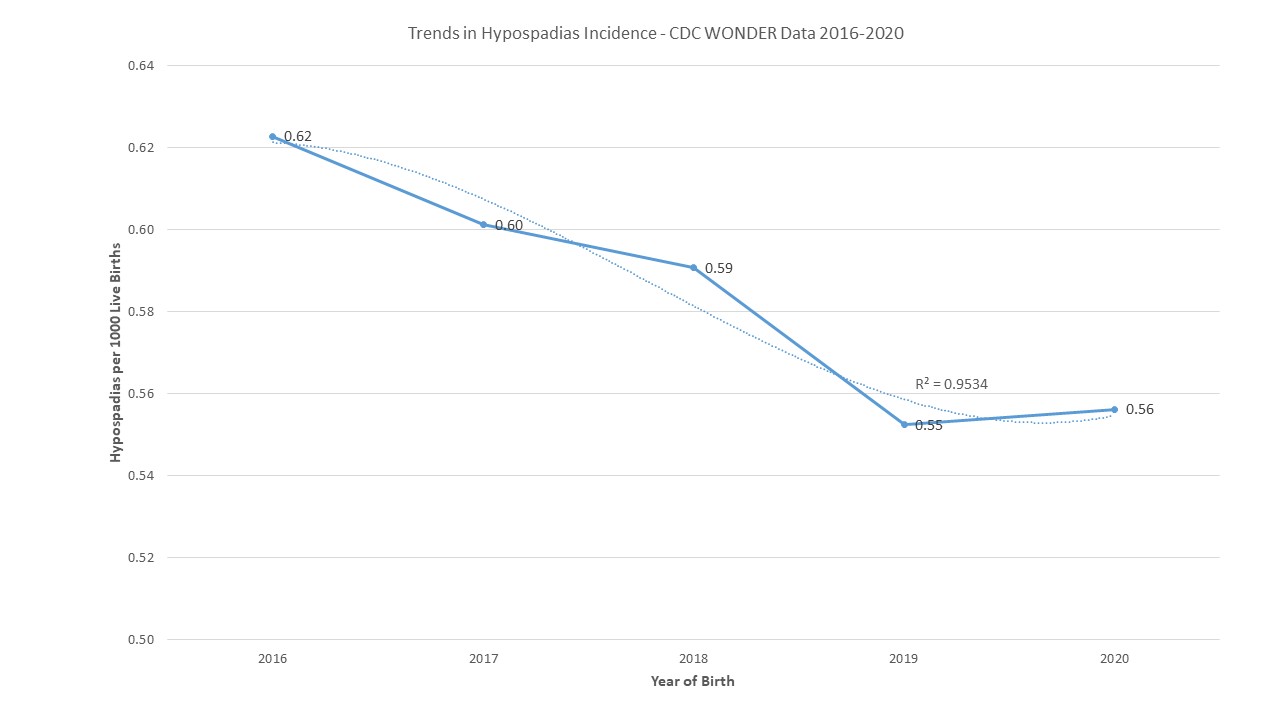Public Health & Prevention
Category: Abstract Submission
Public Health & Prevention II
580 - Hypospadias incidence in the United States (2016-2020) - Association with Prenatal Risk Factors.
Saturday, April 23, 2022
3:30 PM - 6:00 PM US MT
Poster Number: 580
Publication Number: 580.241
Publication Number: 580.241
SANKET P. MISTRY, Connecticut Children's Medical Center, AHMEDABAD, Gujarat, India; Muneeb Zaidi, Connecticut Children's Medical Center, Sanford, FL, United States; Naveed Hussain, Connecticut Children's, Farmington, CT, United States

Naveed Hussain, MBBS, DCH (he/him/his)
Professor of Pediatrics
Connecticut Children's Medical Center
Farmington, Connecticut, United States
Presenting Author(s)
Background: Hypospadias is a common congenital abnormality in newborn males that is tracked by the CDC. There is concern that changes in the prenatal endocrine milieu may affect the incidence of this condition. Factors related to infertility or its treatment, and fetal stress from complications of pregnancy such as diabetes (DM) and hypertension (HTN)) may also be risk factors but epidemiological evidence is lacking.
Objective: Determine temporal trends of hypospadias in the US from 2016-2020, and evaluate the association of hypospadias with factors affecting the prenatal environment.
Design/Methods: Natality information available on CDC Wonder (Wide-ranging Online Data for Epidemiologic Research) was queried for variables of interest for years 2016-20 including the following: birth-year, hypospadias, pregnancy-related factors including – DM, HTN, use of fertility agents, assisted reproductive technologies (ART), and infertility treatment. Residence in metro vs non-metro areas was also evaluated as a surrogate for environmental effects. Incidences were calculated and comparisons were made using the Chi-square test. Odds ratios (OR) with 95% confidence intervals (CI) were calculated. Significance was set at p< .01.
Results: The overall incidence of hypospadias was 0.59/1000 live births. The incidence of hypospadias has decreased significantly from 2016 to 2020 (0.62 to 0.56/1000 live birth, p< .01). (Figure). There were significant racial differences (p < 0.001) in the incidence of hypospadias with white infants having the highest risk followed by African American, American Indian, and Asians having a relatively lower risk. (Table) Pacific Islanders had low numbers and did not reach statistical significance. Hispanic ethnicity was associated with >50% decrease in risk for hypospadias (p < 0.0001). Residents of Metro areas were relatively less likely to have hypospadias (OR.69; 95%CI .62-.77). Infertility treatment for pregnancy increased the odds of hypospadias significantly its sub-categories - assisted reproductive technologies and fertility-enhancing drugs did not reach significance. The high degree of association of hypospadias with pregnancy-related maternal conditions was consistent for all forms of diabetic and hypertensive disorders of pregnancy (Table). Conclusion(s): The decline in the incidence of hypospadias is reassuring. Association of higher incidence in non-metro areas and those using infertility treatments suggests an endocrine disruptor effect. Investigating the higher incidence of hypospadias in pregnancies with diabetic and hypertensive complications may yield clues to preventive strategies.
Trends in Hypospadias Incidence Based on Hypospadias Yes/No and Live Births per year reported in CDC WONDER natality data.
Based on Hypospadias Yes/No and Live Births per year reported in CDC WONDER natality data.
Prenatal Risk Factors for Hypospadias.jpg) Based on Hypospadias Yes/No and prenatal conditions reported in CDC WONDER 2016-2020 natality data.
Based on Hypospadias Yes/No and prenatal conditions reported in CDC WONDER 2016-2020 natality data.
Objective: Determine temporal trends of hypospadias in the US from 2016-2020, and evaluate the association of hypospadias with factors affecting the prenatal environment.
Design/Methods: Natality information available on CDC Wonder (Wide-ranging Online Data for Epidemiologic Research) was queried for variables of interest for years 2016-20 including the following: birth-year, hypospadias, pregnancy-related factors including – DM, HTN, use of fertility agents, assisted reproductive technologies (ART), and infertility treatment. Residence in metro vs non-metro areas was also evaluated as a surrogate for environmental effects. Incidences were calculated and comparisons were made using the Chi-square test. Odds ratios (OR) with 95% confidence intervals (CI) were calculated. Significance was set at p< .01.
Results: The overall incidence of hypospadias was 0.59/1000 live births. The incidence of hypospadias has decreased significantly from 2016 to 2020 (0.62 to 0.56/1000 live birth, p< .01). (Figure). There were significant racial differences (p < 0.001) in the incidence of hypospadias with white infants having the highest risk followed by African American, American Indian, and Asians having a relatively lower risk. (Table) Pacific Islanders had low numbers and did not reach statistical significance. Hispanic ethnicity was associated with >50% decrease in risk for hypospadias (p < 0.0001). Residents of Metro areas were relatively less likely to have hypospadias (OR.69; 95%CI .62-.77). Infertility treatment for pregnancy increased the odds of hypospadias significantly its sub-categories - assisted reproductive technologies and fertility-enhancing drugs did not reach significance. The high degree of association of hypospadias with pregnancy-related maternal conditions was consistent for all forms of diabetic and hypertensive disorders of pregnancy (Table). Conclusion(s): The decline in the incidence of hypospadias is reassuring. Association of higher incidence in non-metro areas and those using infertility treatments suggests an endocrine disruptor effect. Investigating the higher incidence of hypospadias in pregnancies with diabetic and hypertensive complications may yield clues to preventive strategies.
Trends in Hypospadias Incidence
 Based on Hypospadias Yes/No and Live Births per year reported in CDC WONDER natality data.
Based on Hypospadias Yes/No and Live Births per year reported in CDC WONDER natality data.Prenatal Risk Factors for Hypospadias
.jpg) Based on Hypospadias Yes/No and prenatal conditions reported in CDC WONDER 2016-2020 natality data.
Based on Hypospadias Yes/No and prenatal conditions reported in CDC WONDER 2016-2020 natality data.